The outlook behind the Bretton Woods system, along with which the International Monetary Fund (IMF/Fund) and the World Bank (Bank) were born, was to facilitate state intervention in the economy to overcome the limitations of unrestricted capitalism. Both the chief architects of the system, John Maynard Keynes of Britain and Harry Dexter White of the U.S., believed in the necessity of state intervention. Keynes had written a classic book advocating it, and White represented an administration, that of F.D.Roosevelt, whose New Deal had been path breaking.

The Bretton Woods system therefore, permitted countries to impose strict capital controls, so that the state could intervene in the economy without fearing capital flight; and, as a complementary measure, it permitted the imposition of trade controls as well.
The Fund and the Bank operated within this perspective; the former, which is our concern here, gave loans to countries to tide over balance of payments crises. (One of the failures of the Bretton Woods arrangement was its inability to compel countries with balance of payments surpluses to make adjustments, for if they could get rid of their surpluses through greater domestic absorption, then the deficit countries would automatically be rid of their crises).
The IMF of course imposed “conditionalities” like a moneylender, but these had to do with “stabilization” not “structural adjustment”, that is, with correcting macro imbalances to get rid of balance of payments deficits, not with altering the direction of policy. For correcting imbalances it employed a model (the Polak Model) that used only some identities that one could not quarrel with.
The Polak model – an explainer
Per the Polak model, IMF-style adjustment was focused on correcting imbalances in the balance of payments by compressing output, so that at any given import intensity, or ratio of imports to Gross Domestic Product, the import bill can be reduced. This, together with a measure such as currency devaluation, aimed at squeezing out more exports from the system, was expected to deliver correction.
In the Polak model, based on a monetarist view that output is a function of the level of money supply, the onus of adjustment was placed on restraining the supply of money. That adjustment was to occur through a reduction of central bank lending to the government.
In time, the IMF shifted the onus of adjustment to the fiscal side of the macro- economy: governments were required to stop monetizing their deficits or financing them with borrowing from the central bank, and financing of the fiscal deficit had to be curtailed (including by law if needed). The advantage of debt financing via the central bank increased the fiscal space available to the government to meet foreign commitments, while simultaneously working to reduce balance of payments deficits.
The IMF’s role however changed over time alongside changes occurring in the world economy. Enormous concentrations of finance in the hands of metropolitan banks, aided by the two oil-shocks of the 1970s, forced a shift in the channel through which third world borrowing started being financed, from multilateral government “aid” to private commercial loans.
Metropolitan banks had funds they wanted to lend, for which they needed a supervising “monitor”; and third world countries whose deficits worsened because of the oil-shocks, wanted larger amounts of loans than before, for which they also needed an intermediary to arrange loans. The IMF whose own funds were paltry compared to the new needs, became this intermediary-cum-monitor.
It became an instrument through which the agenda of neo-liberal capitalism that international finance capital was keen to promote was actually imposed. It became in effect an agent of international finance capital, pushing countries to undertake “structural adjustment” whose essence lay in a dismantling of the dirigiste regimes they had erected following decolonization.
It favoured flexible and unified exchange rates as opposed to fixed and multiple exchange rates; frowned on bilateral trade arrangements that by-passed the U.S. dollar; wanted “fiscal responsibility legislation” that restricted the fiscal deficit relative to GDP; and encouraged the adoption of a regime of freer cross-border movement of goods and services, and of capital including finance. It pushed in short for a regime and for policies that were the very opposite of the policies Keynes had wanted.
This change had a wider significance. Metropolitan capitalism requires a whole range of primary commodities, not just minerals but tropical and sub-tropical agricultural products that it cannot do without but cannot produce, either at all, or in sufficient quantities, or all the year around.
Since the tropical and subtropical land-mass is more or less fully utilized (and “land-augmenting” technological change requires state activism that is generally eschewed), the metropolis typically wants such supplies to be made available to it by compressing the local absorption of such goods. This could be done easily under colonialism through the taxation system (and the goods were thereby obtained gratis); decolonization however created a problem in this respect, for which the Bretton Woods system had no panacea.
The neo-liberal order that the IMF helped promote filled this gap and thereby created a new imperial arrangement. Whenever the metropolitan demand for some tropical and sub-tropical primary commodity exceeds its supply nowadays and generates inflation, this inflation would be particularly marked in the economy of the periphery; and hence anti-inflationary “austerity” measures would have to be undertaken, for fear otherwise of triggering a capital flight, which would automatically keep down local absorption of the commodity (or its substitute). The IMF has thus become the mid-wife and guardian of a new imperial arrangement.
>>>the writer is an eminent development economist from India and an extensively published author. A Rhodes scholar, he initially taught at the University of Cambridge, UK and later at the Centre for Economic Studies and Planning at the Jawaharlal Nehru University for over 30 years. He also served as the vice-chairman of the Kerala State Planning Board for five years.










